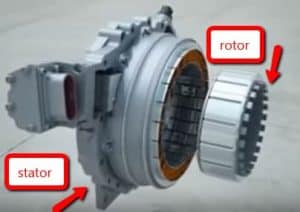 A hybrid car can actually change its own battery. It is able to use its gas motor when the battery is too low to propel forward the car while at the same, charge the battery to the electric motor. A hybrid plug-in is a hybrid that can be plugged into an electrical outlet, this is another way for the hybrid to charge its battery. I will explain in detail the process used that allows a hybrid to charge its own battery.
A hybrid car can actually change its own battery. It is able to use its gas motor when the battery is too low to propel forward the car while at the same, charge the battery to the electric motor. A hybrid plug-in is a hybrid that can be plugged into an electrical outlet, this is another way for the hybrid to charge its battery. I will explain in detail the process used that allows a hybrid to charge its own battery.
How does a hybrid car charge its battery? A hybrid car uses regenerative braking to charge its battery. Regenerative braking turns as much as 70 percent of the kinetic energy that deceleration creates into electricity. This electricity is stored in the batteries that supply power to the electric motor.
What is Regenerative Braking?
Personally, I have a plug-in hybrid. I try my best not to slam on the brakes to stop. If you hit the brakes hard, the friction brakes kick in. Friction brakes cause heat and this energy is released into the atmosphere. It is not stored or used in any way by your hybrid car. In essence, it is wasted energy. Kind of like throwing cash out of an open window.
Regenerative braking is a property that hybrid cars have that will convert this kinetic energy created by your car due to its mass and velocity after you have accelerated. As much as 70 percent of the kinetic energy will be converted into electricity that will be stored into the lithium battery pack that supplies power to your electric motor.
How do you Initiate Regenerative Braking?
Causing regenerative braking to happen was a difficult topic to research. The internet is full of regenerative braking misconceptions. It was as if 90 percent of the posts that I read stated that you need to apply the brakes to cause regenerative braking to kick in.
This is not true. Regenerative braking is a property, it does not necessarily take equipment to initiate it. It happens when the car starts to decelerate. To initiate regenerative braking, all that you need to do is to take your foot off of the ‘gas’ pedal. Your car will slow down because of the forces that will be applied to it. I will explain later these forces.
With my plug-in hybrid Hyundai Sonata, I have noticed that there is not a lot of charging happening as soon as I take my foot off of the accelerator, but it is apparent. On the dashboard, there is a blue section that indicates when regenerative braking is sending current to the battery. It only goes up a few notches when I take my foot off of the gas pedal.
Nevertheless, as I glide to a stop, I will need to press on the brakes. At this time, I notice that the level of charging is at its highest level. At a full stop, the regenerative braking has fully stopped, the needle that shows the level of charging is at zero.
What Slows down the Hybrid Car Before You Apply the Brakes?
When I was researching why my hybrid car slows down after receiving the accelerator, I thought that there might be some magical tactic that was designed into my hybrid. At first, I thought that the stator where the rotor sits in the electric motor, was reversing its polarity and that was reducing the spin on the rotor.

I had read that explanation on many forums and sites. After noticing the contradictions, I decided that I would stick with auto engineering sites that explained in detail the inner workings of hybrid cars.
There are many reasons as to why a hybrid car starts to slow down after you have released the gas pedal. It has to do with the friction that is created on any object that has built-up kinetic energy.
Any object that is in motion has kinetic energy. Kinetic energy is calculated using the mass and the velocity of an object. The kinetic energy for the movement of the car is transitional kinetic energy. It can be calculated as follows:

| Variable | What is it? |
|---|---|
| KE | kinetic energy |
| v | velocity of the car |
| M | weight of the car |
For a moving hybrid car, there is also rotational kinetic energy that is created by the rotation of the four tires. Here is the formula for rotational kinetic energy plus the transitional kinetic energy, which provides the total kinetic energy for a car. The result is in joules:

- the small m is the mass for the tires only
When regenerative braking starts, the kinetic energy in the rotor is converted into a current. This current is sent to the lithium battery pack which charges it. You are not going to get 100 percent of the kinetic to convert. A portion of it will be dispersed into the atmosphere. Nevertheless, I have read that as much as 70 percent will get converted into electricity.
As soon as you let go of the accelerator, generative braking starts because the rotor begins to slow down. Here are the frictional forces that start to reduce the speed which in turn slows down the spinning of the rotor that is within the stator:
| Frictional Force | Description |
|---|---|
| Aerodynamic Friction Losses | The drag creating by air pushing on the car |
| Rolling Friction Losses | Losses caused by gravity, the slope angle, road surface, and even the level of air pressure in the tires |
| Frictional Loss Due to Gravity | Gravity pulls down the vehicle especially as the speed decreases |
Why is City Driving Better for Regenerative Braking?
When you are in a traffic jam situation in a city, there is a ton of stops and goes required. Each time that you release the accelerator, you will be starting the regenerative braking that will charge your battery pack.
Of course, there is going to be a lot less kinetic energy built up because of the lower speed of your hybrid while driving in the city, since the kinetic energy level is influenced by mass and speed. Nevertheless, converting any kinetic energy into a current is a bonus that you do not get with a non-electric motor.
How should you drive in the city to maintain a high level of regenerative braking?
I have tried a few tactics to maximize the level of regenerative braking. I drive a lot in a city setting personally. I have noticed that coasting to a stop is the best policy. It does not create a high level of regenerative braking, but it does occur according to the reading on my dashboard. The needle usually indicates a level of 15 percent of the maximum level for regenerative braking when I release the accelerator.
My Hyundai Sonata Plug-in Hybrid does not come to a complete stop unless I apply some braking when on a level surface. Once I apply the brakes, the amount of regenerative braking that is converted to current is at a high level. The needle can sometimes reach around 80 percent of its maximum in the blue range which is the charging range for the lithium battery pack for my vehicle.
If I play around with coasting and braking, I can usually accomplish regenerative braking about half of the time while driving a few miles.
How Much is the Battery Charged Just Through the Use of Regenerative Braking?
I found an article written on fueleconomy.com that states that city driving get regenerate as much as 32 percent of the charge in the electric battery pack. They also indicate that highway driving is less efficient, and that regenerative braking will add only an extra 6 percent to the battery pack charge.
I read on many forums that people are saying that regenerative braking does not increase the distance that you can travel on electric power. They say that when you are slowing down that regenerative braking charges the battery, but that you will use up this bonus energy to accelerate to your previous speed.
This concept sounded silly to me. Why have regenerative braking at all if there is no added benefit. Is regenerative braking just another marketing scheme like some teeth whitening tubes of toothpaste that have zero effect on the whiteness of your teeth?
So, I decided to do my own tests. I did not do this on a grand scale, but I was amazed nevertheless at the results. Always daily, I drive to my local gym. The round-trip is 4.3 miles. Here are my results showing the possible travel distances using electric, and the actual distances traveled:
| odometer reading | indication of distance that can be traveled using electric motor |
|
|---|---|---|
| start of trip to gym | 1828 | 27 |
| once at home ( after round-trip to gym) | 1833 | 23 |
According to the above figures, I should only have 22 miles left that could be traveled electrically after my trip to the gym. However, I had 23, which indicates that regenerative braking added 20 percent to my charge. I realize that this experiment is flawed somewhat because of the short distance that I had traveled. Still, I feel that a 32 percent increase in the distance, because of regenerative braking, that you could possibly travel within a city is not far fetched.
